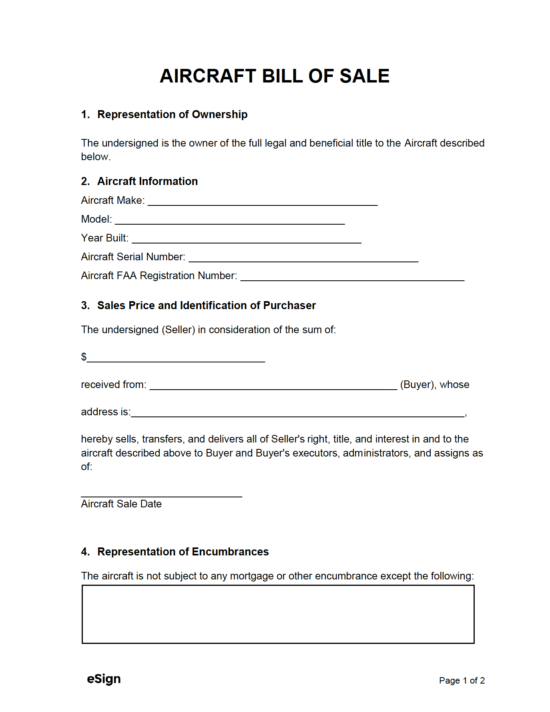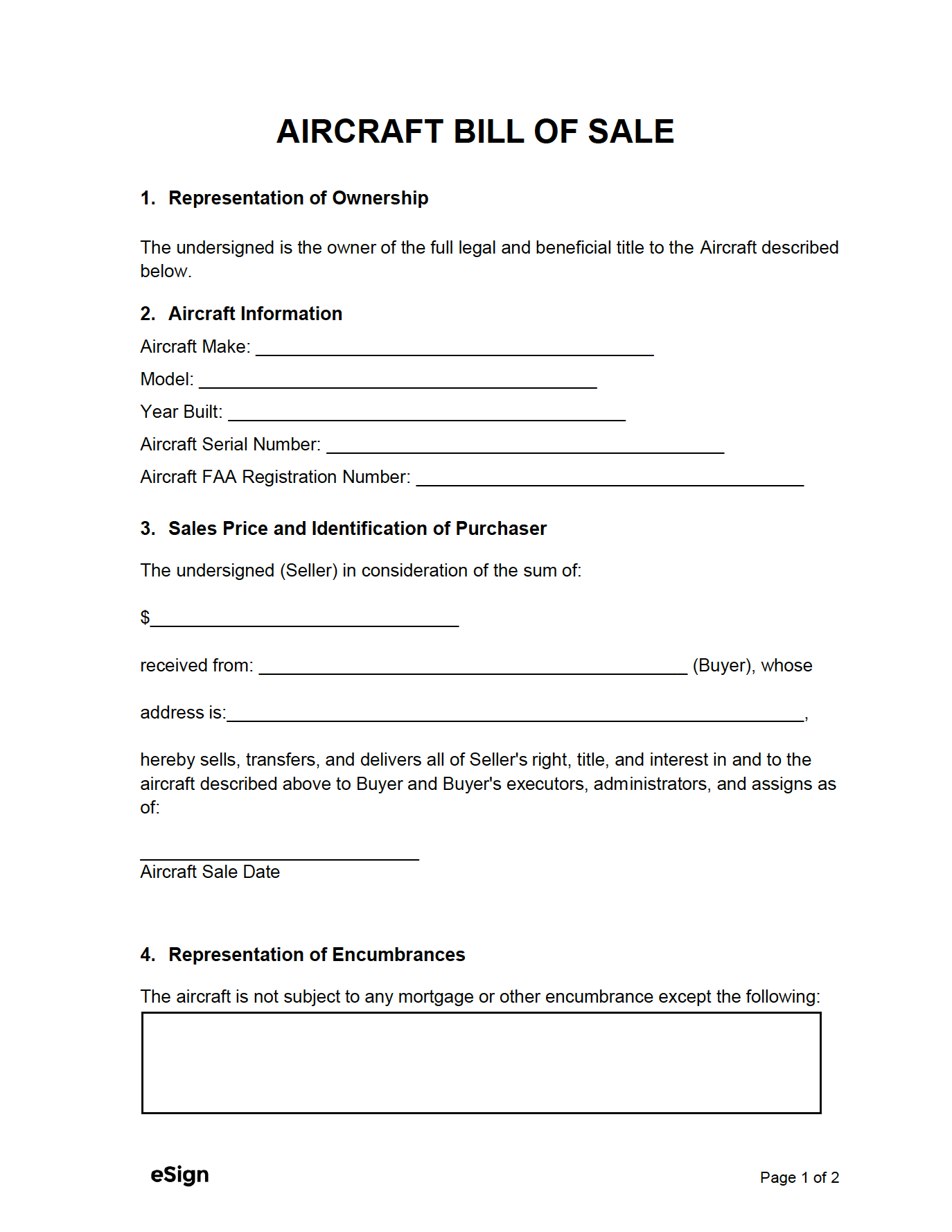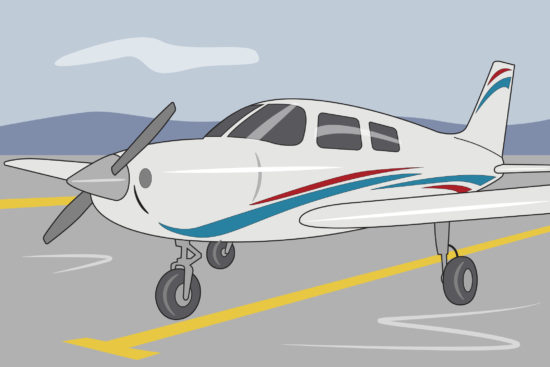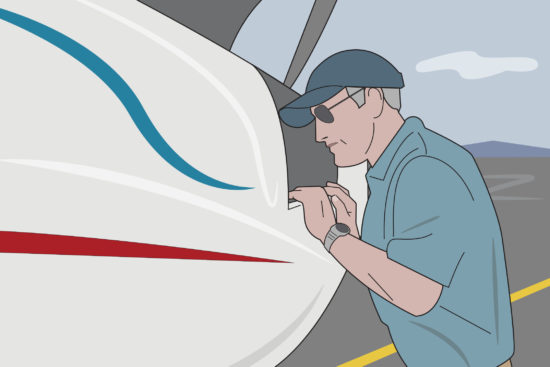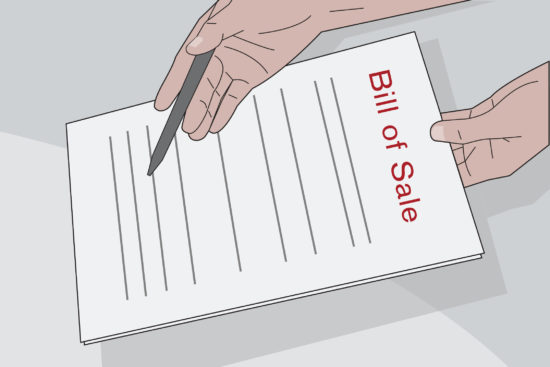Document Features
- Official – This is the official aircraft bill of sale authorized by the Federal Aviation Administration (FAA).
- FAA Recording – A blank space is provided so FAA staff at the aircraft registration offices can enter information and stamps when processing the bill of sale.
- Consideration – The bill of sale clearly states the price the buyer will pay the seller for the legal title of the aircraft.
- Aircraft Information – The aircraft’s registration number, manufacturer, model, and serial number are included to help avoid misunderstandings.
How to Sell an Airplane
Step 1 – Determine the Plane’s Value
For owners who aren’t experienced in selling, seeking assistance from an airplane appraiser is recommended. According to the Aircraft Owners and Pilots Association, there are three types of appraisal of varying thoroughness, as listed below.
- Pricing Digest Valuation (Cost: Free) – Includes a “VREF” Aircraft value reference tool.
- Desktop Appraisal (Cost: ~$500-600) – An appraisal service (not in person).
- Physical Appraisal (Cost: ~$2,000-3,000) – An appraisal service done in person.
Step 2 – Use a Broker / List Online
Aircraft owners can sell their planes themselves by listing them on various online platforms or hiring a broker to handle the transaction. It’s possible that a broker will have an appraisal service they regularly use.
Step 3 – Negotiate the Price / Inspection
Once a prospective buyer has been found, negotiations will begin. If the buyer is seriously interested in purchasing, they will most likely request a pre-purchase inspection for the aircraft. Depending on the thoroughness of the inspection and the size of the plane, this can take several hours.
Step 4 – Receive Funds & Complete the Bill of Sale
If the buyer is committed to the purchase, the seller can complete (most of) the aircraft bill of sale ahead of time to speed up the signing process. Because the form is used to register the plane, it’s important that all the fields are completed accurately.
Once the seller has received the funds, the parties can sign the contract. While the form does not specifically require that the signatures be notarized, some local laws may require it.
Step 5 – Transfer the Aircraft
Once the aircraft has been successfully sold, the seller will need to do the following:
- Take the aircraft’s registration, complete the fields pertaining to selling, and mail it to the FAA.
- Cancel the aircraft’s insurance.
- If the seller has an FCC radio license in the aircraft, this should be removed.
- Hand over all logbooks and records regarding the aircraft to the new owner.
The new owner will need to register the aircraft by mailing AC Form 8050-1 and a copy of the completed bill of sale to the FAA.
Sample
Download: PDF
AIRCRAFT BILL OF SALE
1. REPRESENTATION OF OWNERSHIP.
The undersigned is the owner of the full legal and beneficial title to the Aircraft described below.
2. AIRCRAFT INFORMATION.
Aircraft Make: [MAKE]
Model: [MODEL]
Year: [YYYY]
Aircraft Serial Number: [SERIAL #]
Aircraft FAA Registration Number: [REG #]
3. SALES PRICE AND IDENTIFICATION OF PURCHASER.
The undersigned (Seller) in consideration of the sum of $[PURCHASE PRICE] received from [BUYER NAME] (Buyer), whose address is [BUYER ADDRESS], hereby sells, transfers, and delivers all of Seller’s right, title, and interest in and to the aircraft described above to Buyer and Buyer’s executors, administrators, and assigns as of [MM/DD/YYYY] (Aircraft Sale Date).
4. REPRESENTATION OF ENCUMBRANCES.
The aircraft is not subject to any mortgage or other encumbrance except the following: [LIST MORTGAGE / ENCUMBRANCES (IF ANY)].
5. SIGNATURES.
The Buyer accepts receipt of this Bill of Sale and understands that the above Aircraft is sold in “as is” condition with no guarantees or warranties (other than any remaining factory warranty), either expressed or implied, for the Aircraft.
IN WITNESS THEREOF, the Buyer and Seller agree on the terms herein contained in this Bill of Sale.
Buyer Signature: _________________________ Date: [MM/DD/YYYY]
Printed Name: [BUYER NAME]
Seller Signature: _________________________ Date: [MM/DD/YYYY]
Printed Name: [SELLER NAME]
